by Blair Haas, Bud Industries Inc.
The selection of a cabinet, enclosure, or other packaging for an electronic product presents the designer or systems integrator with a variety of choices, in addition to certain criteria that will be dictated by the nature of the application. This article summarizes the basic types of electronics cabinets and enclosures available in the marketplace today, along with some of the more important issues of packaging for electronic systems and products. Using this information, designers can begin to evaluate their options quickly, so they can focus on selecting the optimum solution for their applications. Remember, many enclosure solutions can be delivered with custom features or modifications that tailor them precisely to a particular application.
Electronics cabinet, server, and co-location racks
Floor-mount enclosed rack cabinets are among the largest enclosures used in electronic applications, and are offered in many styles and with a wide range of accessories. Cabinet racks are available with a 19, 23, or 24-in.-wide panel space.
An enclosed cabinet for electronics t is a good choice where rack-mountable equipment needs to be housed safely and securely. An enclosed rack offers a controllable environment for equipment cooling. Ventilated panels and various types of fan trays and arrays are available to manage airflow, which has become increasingly critical as the power demands of some types of systems escalate. Many enclosed electronics cabinet designs accept lockable accessory front and rear doors to provide equipment security, or transparent doors to permit equipment monitoring.
The choice of a specific model depends on load, accessibility cosmetic and configuration requirements, and any applicable standards.
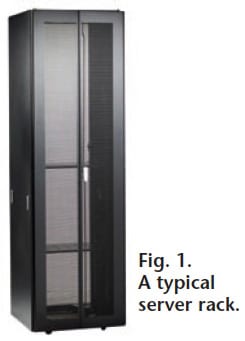 Server (Figure 1) and co-location racks are ideal for applications requiring maximum ventilation and air flow. Server racks are similar to cabinet racks, except that side panels and doors are heavily ventilated. A locking, solid metal or transparent front door may be used for protection and security. Extra cabinet depth permits mounting of deeper instruments or equipment.
Server (Figure 1) and co-location racks are ideal for applications requiring maximum ventilation and air flow. Server racks are similar to cabinet racks, except that side panels and doors are heavily ventilated. A locking, solid metal or transparent front door may be used for protection and security. Extra cabinet depth permits mounting of deeper instruments or equipment.
Co-location racks resemble server racks that have been divided up into individual compartments. Individual sections are designed to be fully independent and secure, and are available in heights ranging from approximately 24 to 39 in. Typically, each section has its own door. Side panels may be one-piece units that extend the full height of the cabinet rack assembly.
Seismic racks
Seismic racks offer the maximum level of seismic protection for equipment to be operated under conditions of shock or vibration. Seismic cabinets are rated according to Telcordia (formerly Bellcore) #63-GR-CORE standards, with Zone 4 representing the most demanding requirements.
The rated weight carrying capacity of a cabinet is normally based on a uniformly distributed load. If your cabinet will be used in a shock or mobile environment (i.e. aboard trucks or ships), testing under the actual or simulated load conditions may be necessary.
Seismic cabinets should be anchored to the floor with a suitable anchor kit
Open-frame racks and wall-mount cabinets
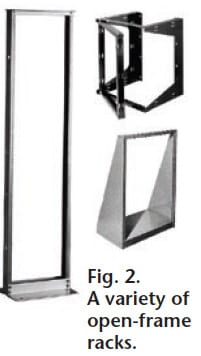 Open frame racks are a good choice in applications requiring maximum cooling, or free and immediate access to the front, rear, and sides of equipment – no doors or side covers are used (Figure 2). Open frame racks are available to accept 23-in. as well as 19-in.- wide instrument panels. If security is a concern, open frame racks should be used within lockable rooms.
Open frame racks are a good choice in applications requiring maximum cooling, or free and immediate access to the front, rear, and sides of equipment – no doors or side covers are used (Figure 2). Open frame racks are available to accept 23-in. as well as 19-in.- wide instrument panels. If security is a concern, open frame racks should be used within lockable rooms.
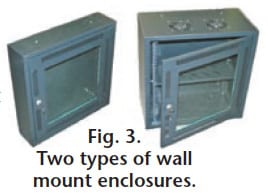 Wall-mount and desktop racks are a shorter version of the open rack for use where floor space is not available. Wall mount cabinet enclosures (Figure 3) are a cost effective alternative where equipment needs are modest and not likely to increase for an application.
Wall-mount and desktop racks are a shorter version of the open rack for use where floor space is not available. Wall mount cabinet enclosures (Figure 3) are a cost effective alternative where equipment needs are modest and not likely to increase for an application.
Wall mount server cabinet designs include fixed types, as well as “swing-frame” types that open away from the wall to provide rear panel access. Loads are supported completely by the rails comprising the rack frame. Make sure that the load capacity is adequate for the application, and that the base is large enough to provide stability for the rack as it will be populated.
Double-hinged split cabinets are also available, which open like a book to offer access to rear panels, or to provide multiple layers of rack mounting space. Lockable and transparent doors are available on some models.
Rackmount chassis and card racks
Rackmount chassis provide a range of enclosures for the assembly of rack-mountable equipment and instruments. Some rack mountable equipment may also be used as desktop or portable equipment, so detachable handles, rack mounting brackets, or other hardware may be desirable. Availability of ventilation panels is also important to maintain safe operating temperatures.
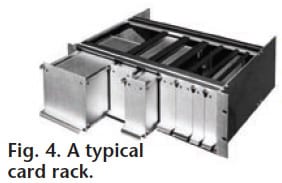 Card racks (Figure 4) are chassis-like enclosures used to assemble circuit boards and components into modular electronic instrumentation. The card rack itself is designed to mount in a 19 in rack equipment. Modules can be changed or rearranged for quick equipment modification.
Card racks (Figure 4) are chassis-like enclosures used to assemble circuit boards and components into modular electronic instrumentation. The card rack itself is designed to mount in a 19 in rack equipment. Modules can be changed or rearranged for quick equipment modification.
Modular systems can hold a number of individual sub-modules, each of which must mesh with rails, guides, connectors, lock screws, and other hardware within the modular chassis. Dimensional precision and stability are important to eliminate the possibility of binding and misalignment.
Portable and small metal cabinets, and chassis
Portable cabinets are small cabinet racks used to house a limited amount of 19″ wide instrumentation or equipment. Internally, portable cabinets offer limited space for power strips and other accessories. Generally, no internal framework is present. Externally, portable cabinets accept rubber feet, but not casters, levelers, or anchor kits.
The weight capacity may be up to 500 pounds. Heavily loaded cabinets should be supported on sturdy surfaces. Small cabinets are used to package instrumentation and equipment requiring a maximum volume of approximately 1 cubic foot. Small cabinets include convenience features such as strap handles, sloping fronts, tilting bails, and latches, to name a few. They are generally not intended for rack mounting, although mounting hardware may be available for some types.
Metal chassis provide support and protection for electronic circuits. A bottom cover is often available. Check dimensions and accessories for specific chassis models.
Small enclosures
This group can be broken down into six categories: die-cast metal; NEMA 4 die-cast; UL and NEMA 4X polycarbonate and ABS; molded ABS; hand-held; and economy/utility/potting boxes (Figure 4). Die-cast metal boxes are typically aluminum with covers and come in sizes ranging to approximately 9 x 6 x 3 in. Typical applications include housing of electronic and electrical assemblies, pneumatic and hydraulic devices, and other applications requiring a sturdy enclosure.
NEMA 4 die-cast aluminum enclosures typically offer sealed construction and/or gasketing for resistance to atmospheric contaminants, spray, and corrosion. They are designed to IP65 of IEC529 and NEMA 4 specifications, and available with wall mounting holes and cover. Attaching screws are outside the sealing area to prevent entry of moisture and dust, and the cover incorporates a recessed gasket. Most models have internal guides for mounting PCBs and finishes are usually natural or gray. Typical applications include housing of sensitive electronic assemblies and other applications requiring a sealed enclosure.
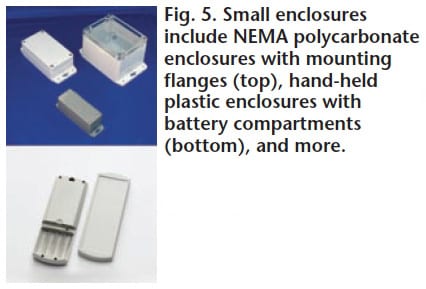 UL and NEMA 4X polycarbonate, and ABS enclosures (Figure 4) are similar in appearance to NEMA 4 aluminum enclosures, except they are constructed from polycarbonate or ABS plastic, and satisfy specific NEMA, UL, or IEC codes. They may contain panels, pc-board guides, or mounting bosses. Transparent doors or covers may be available, and sizes range to around 24 x 16 x 10 in. Typical applications include housing of sensitive electronic assemblies and applications requiring a sealed enclosure.
UL and NEMA 4X polycarbonate, and ABS enclosures (Figure 4) are similar in appearance to NEMA 4 aluminum enclosures, except they are constructed from polycarbonate or ABS plastic, and satisfy specific NEMA, UL, or IEC codes. They may contain panels, pc-board guides, or mounting bosses. Transparent doors or covers may be available, and sizes range to around 24 x 16 x 10 in. Typical applications include housing of sensitive electronic assemblies and applications requiring a sealed enclosure.
Molded ABS plastic cases are available in various shapes and sizes, with features such as sloped or flat panels, removable panels, interlocking “clamshell” case halves, and internal reinforcements. They provide a finished appearance and are available in a variety of colors. Guides and bosses may be present for mounting pc boards, and rubber feet may be included. Sizes typically range to about 24 x 16 x 10 in. Typical applications include instrumentation, telecom, and data acquisition equipment.
Hand-held enclosures are designed for portable and pocket applications, and can have ergonomic shapes, interlocking lids, access panels for batteries, equipment windows for displays, as well as many features of standard molded plastic cases. Typical applications include consumer electronics and remote controls.
Economy, utility, and potting boxes offer basic packaging and protection for small circuits and components. Economy metal and plastic boxes are generally offered unfinished, or in a limited number of colors. Covers are usually available, and sizes range to approximately 6 x 6 x 6 in. Typical applications include small electronic devices and accessories, prototypes, and potted assemblies.
While a basic understanding of electronic cabinets and enclosures is the first step in selecting a system housing, there are obviously other things to consider. The Enclosure Design Tips Handbook, available at www.budind.com, will help you further in the process.

 Server (Figure 1) and co-location racks are ideal for applications requiring maximum ventilation and air flow.
Server (Figure 1) and co-location racks are ideal for applications requiring maximum ventilation and air flow. 
 Wall-mount and desktop racks are a shorter version of the open rack for use where floor space is not available.
Wall-mount and desktop racks are a shorter version of the open rack for use where floor space is not available.  Card racks (Figure 4) are chassis-like enclosures used to assemble circuit boards and components into modular electronic instrumentation. The card rack itself is designed to mount in a
Card racks (Figure 4) are chassis-like enclosures used to assemble circuit boards and components into modular electronic instrumentation. The card rack itself is designed to mount in a  UL and NEMA 4X polycarbonate, and ABS enclosures (Figure 4) are similar in appearance to NEMA 4 aluminum enclosures, except they are constructed from polycarbonate or ABS plastic, and satisfy specific NEMA, UL, or IEC codes. They may contain panels, pc-board guides, or mounting bosses. Transparent doors or covers may be available, and sizes range to around 24 x 16 x 10 in. Typical applications include housing of sensitive electronic assemblies and applications requiring a sealed enclosure.
UL and NEMA 4X polycarbonate, and ABS enclosures (Figure 4) are similar in appearance to NEMA 4 aluminum enclosures, except they are constructed from polycarbonate or ABS plastic, and satisfy specific NEMA, UL, or IEC codes. They may contain panels, pc-board guides, or mounting bosses. Transparent doors or covers may be available, and sizes range to around 24 x 16 x 10 in. Typical applications include housing of sensitive electronic assemblies and applications requiring a sealed enclosure.